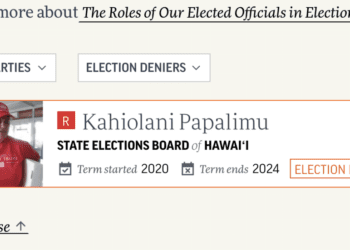Editor’s note: For Hawaii’s Nov. 5 General Election, Civil Beat asked candidates to answer some questions about where they stand on various issues and what their priorities will be if elected.
The following came from James Hustace, candidate for Hawaii County Council District 9, which includes North and South Kohala. The other candidate is Cindy Evans.
Go to Civil Beat’s Election Guide for general information, and check out other candidates on the General Election Ballot.
1. What is the biggest issue facing your district, and what would you do about it?
The county district of North and South Kohala faces an array of challenges and addressing our infrastructure is key to solving these issues. We must ensure that our road networks provide a safe and equitable space for commuters, buses, pedestrians, and cyclists as we pursue efforts to limit the cost of commuting and focus growth around urban centers.
We must tackle challenges with water, solid waste, wastewater and broadband, protecting our aina and delivering critical services that will help to alleviate the financial strain on families. We will need to expand our mass transit network, allowing more options for our workforce and to reduce traffic congestion.
Additionally, we have a need to enhance and maintain our park spaces with the potential of partnering with the community to help guide the process.
A focused effort on these issues will also help us to address our increased cost of living. Ultimately, investment in our infrastructure through securing capital improvement funds, partnership with state and federal representatives, or utilizing our Ccunty’s strong bond rating can help us to tackle the challenges of protecting our communities, improving our watershed health and enhancing community resilience through system redundancy and proactive maintenance.
2. Overtourism can degrade the environment, threaten biodiversity, contribute to wear and tear on infrastructure, generate traffic and disrupt neighborhoods. What do you think about the amount of tourism on the Big Island and how it’s managed?
Hawaii will always be a destination where visitors come to experience the beauty of our islands and learn about our culture. Together we can pursue destination management policies and goals where guests have a greater opportunity to experience cultural aspects of our islands, learn about our history through educational activities, engage as environmental stewards and practice volunteerism during their visit to enhance community and build relationships.
We must work with community partners to develop management plans for our celebrated places, our wahi pana. We need to analyze strategies that are employed across the state (such as Haena on Kauai and Hanauma Bay on Oahu) that help to mitigate overcrowding and manage environmental issues.
We can partner with community organizations, businesses and government agencies to find the most appropriate model to support the economy and strive to preserve and protect the aina. We must dedicate TAT funds toward these efforts and help to manage impacts, all while enhancing infrastructure.
3. What needs to happen to relieve traffic congestion in and around Kailua-Kona and along the Puna-Keaau-Hilo corridor?
While these specific locations are not in the district I seek to represent, these traffic challenges impact our county workforce and residents. It is important to understand that these issues have been building for a long time.
Moving forward, we need community engagement and proactive planning that recognizes these challenges as communities grow. We need to ensure that capacity is met with requirements to alleviate the strain on existing systems.
As we deal with these current issues, we need to work with our state legislators to fund studies that help us identify the most appropriate alternative routes, collaborating with the community during the process and respecting cultural and historic spaces.
Additionally, there is a need to enhance our mass transit capacity and incentivize off-peak travel. We need to identify ways that limit commuting impacts by developing walkable communities and expanding opportunities of live-work-play models.
Here in North Hawaii, we need to focus efforts and work with our state and federal partners to complete the Daniel K. Inouye Highway extension and pay close attention to Kawaihae Road, given the growth of surrounding communities.
4. The cost of living on Hawaii island is rising rapidly. How are working and middle-class people expected to buy a house or pay the rent as well as take care of other expenses? And how can the county government help?
We can help to stabilize the high cost of living by pursuing initiatives at the county level that will expand the middle housing sector and fund housing projects that are affordable for our residents. We can also identify vacant homes in our communities, bring them back up to code, and get them into the long-term rental market. These avenues can help local families build capital to become first-time homeowners.
Through policy and community advocacy we can focus growth in urban centers, limit sprawl, provide more reasonable housing options for families and expedite UXO clearance. We need to expand our workforce and elderly housing capacity in partnership with the state and private entities, enhance mass transit capacity, address zoning challenges and encourage mixed-income developments.
We will need to look at our property tax policies and assessments within Chapter 19 that inadvertently impact local families. We can additionally confront cost of living challenges by creating economic diversity through partnership and collaboration with the business community, expanding SNAP benefits, enhancing our STEAM (science, technology, engineering, arts and math) education pipeline and growing our workforce training programs.
5. Do you support the construction of the Thirty Meter Telescope on Mauna Kea?
As a Native Hawaiian I support astronomy as an important means to diversify our economy by strengthening workforce pathways for STEAM education, expanding our knowledge industry and collaborating with international partners through the lens of the Hawaiian language and culture. We have work to do to create balance, both environmentally and culturally, as we honor the commitments to decommission older observatories and restore the aina.
While this is a state issue, through collaboration we can establish a partnership with community leaders, elected officials and representatives on the Mauna Kea Stewardship Oversight Authority Board, ensuring that they have the authority to guide the process.
Our ancestors traveled here by the stars and our future generations should be allowed this opportunity to observe and continue this legacy, sharing our culture, heritage and knowledge gained here with the world.
6. Homelessness remains a problem statewide, including on Hawaii island. What would you do to come to grips with this persistent problem?
While the 2024 Point in Time Count for Hawaii County shows a 28% reduction in those experiencing homelessness in the last year, we must continue to support families and communities by tackling cost of living challenges.
We need to continue our partnership with community nonprofits that engage with our homeless and houseless populations on a regular basis. We need to support comprehensive services (such as health, mental health, social-emotional wellness, substance abuse) for homeless individuals and our veterans in our communities. We will need to expand workforce and language training opportunities to best connect with these impacted community members.
We also have an opportunity to expand our housing capacity, offering affordable and workforce units to those living paycheck to paycheck. We can identify opportunities for transitional and supportive housing to help individuals take the necessary steps to become independent and active in the community. Identifying vacant homes in our communities and bringing them back up to code can also increase our long-term housing rental capacity.
7. Half of Hawaii’s cesspools are on the Big Island, some 49,300. Seepage from cesspools can make people sick, harm coral reefs and lead to a variety of ecological damage. By law, cesspools must be upgraded to septic systems by 2050. What can be done to help people who may not be able to afford the conversion?
We have an opportunity to work with state and federal partners to solve wastewater challenges and to tackle the undue cost and burden on our residents. Many of our local families will struggle with this added cost of converting their own system. The mandate placed on our state and counties by the federal government is largely unfunded and we must work collaboratively to transition older systems and prioritize areas that have the greatest impact on our shoreline ecosystem.
Through outreach, education and incentives we can help our rural communities with limited access to public infrastructure. When pursuing infrastructure projects, we must assess the communities of concern and need, pursue appropriate funding options, explore possibilities of public-private partnership and invest in existing systems to modernize and bring them into compliance.
Maintenance is needed for our existing wastewater infrastructure system in Hilo that could cause major and lasting damage to our coastal environment and impact the health of our residents, especially that of our Native Hawaiian community in Keaukaha. We also have an opportunity to facilitate community dialogue and take action following the publication of the County Integrated Wastewater Management Plan and the Puako and South Kohala Regional Wastewater Master Plan.
8. What is the first thing Hawaii County should do to get in front of climate change rather than just reacting to it?
While attaining a master’s degree in Public Administration at Hawaii Pacific University, I researched and explored the future challenges of sea level rise on specific economic sectors and major connection points of Hawaii Island (Hilo Bay, Kailua Bay, and Kawaihae Harbor). I utilized previous academic studies with geographic information systems to analyze the economic and physical impact to these areas through maps and measurements over time.
As a county, we need to take proactive steps to prepare our island for sea level rise and extreme weather events through policy, education and labor. We need to engage early on with the community and businesses to find solutions and understand the overall impact.
Through this collaboration we need to identify assets within inundation zones, assess critical infrastructure and analyze the cost of mitigation, adaptation and migration. We need to analyze risk and employ modeling to determine economic losses and the impact to our transportation networks.
We also should seek to be more self-reliant by expanding our agricultural capacity and our renewable energy portfolio. I hope to engage with the future state roadmap that will guide efforts to reduce our climate impact following the recent lawsuit led by Keiki O ka Aina.
9. Should the Hu Honua biomass energy plant be allowed to start operating? Why or why not?
I dream of a day where we can decarbonize our grid and our transportation network. Unfortunately, we are not there yet. It will take commitment to recognize the trade-offs from each energy system when expanding our renewable energy portfolio.
We need to look at and identify a diverse network of energy generation capacity for the purpose of creating a stable and modern grid that can accommodate for extreme weather events or lack of resources. We also have an opportunity to export energy and transition our nonpoint sources by investing in hydrogen capacity.
In time, a carefully crafted state energy plan can help guide us as we phase out older systems, identify the challenges of an isolated state, utilize our existing assets and achieve grid stability. We need to enhance community resilience and tackle the challenges of rolling blackouts due to aging infrastructure, energy shortfalls and forthcoming impacts of newly implemented power shutoff policies during high wind events.
At the same time, we will need to invest in current systems, prepare for future challenges and make the transition for a better tomorrow.
10. How would you make the county administration more transparent and accessible to the public?
Being a recipient of the 2020 Big Island Press Club Torch of Light Award as part of my leadership efforts with the Waimea Community Association, it is important to me that the community has the ability to engage and freely access knowledge. We must strive for consistent community meetings across our districts for the purpose of connecting with residents and addressing concerns.
We have an opportunity to enhance communication capabilities with our emergency services and civil defense to better inform residents. We can also tap into existing social media resources to share information and improve delivery on our county website.
This will require an investment in upgrading technology and employing public information officers, creating opportunity for dialogue on issues, collaboration between partners and encouraging engagement.

Sign up for our FREE morning newsletter and face each day more informed.
Sign Up
Sorry. That’s an invalid e-mail.
Thanks! We’ll send you a confirmation e-mail shortly.
Source link : http://www.bing.com/news/apiclick.aspx?ref=FexRss&aid=&tid=66f602651f9a413daddcea451c412416&url=https%3A%2F%2Fwww.civilbeat.org%2F2024%2F09%2Fcandidate-qa-hawaii-county-council-distict-9-james-hustace%2F&c=5052498077358806900&mkt=en-us
Author :
Publish date : 2024-09-26 13:30:00
Copyright for syndicated content belongs to the linked Source.




